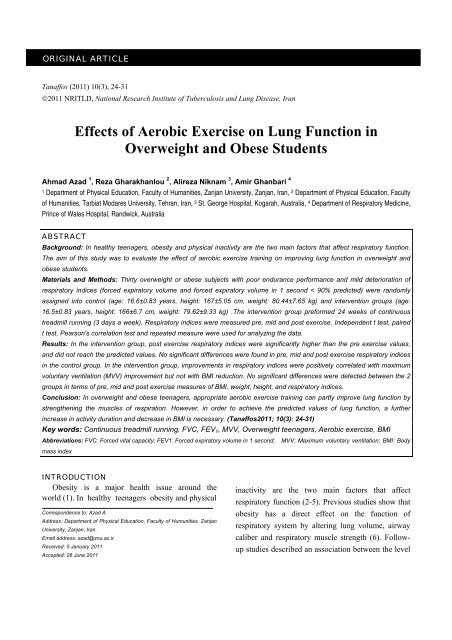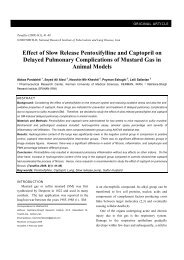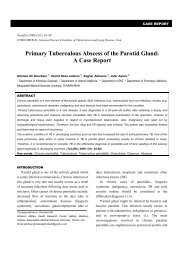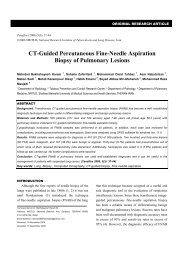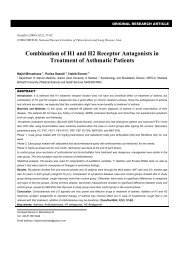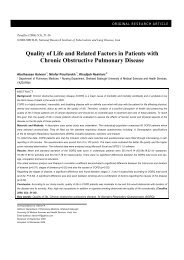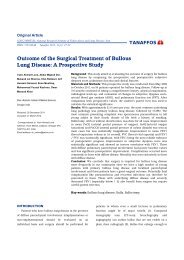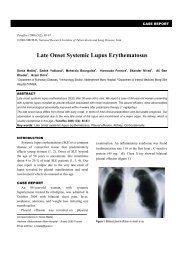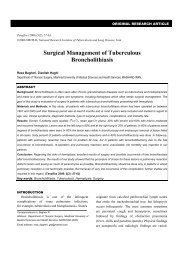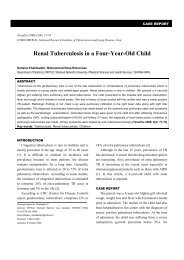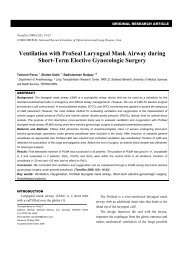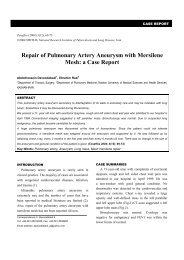Effects of Aerobic Exercise on Lung Function in ... - Tanaffos
Effects of Aerobic Exercise on Lung Function in ... - Tanaffos
Effects of Aerobic Exercise on Lung Function in ... - Tanaffos
You also want an ePaper? Increase the reach of your titles
YUMPU automatically turns print PDFs into web optimized ePapers that Google loves.
ORIGINAL ARTICLE<br />
<strong>Tanaffos</strong> (2011) 10(3), 24-31<br />
©2011 NRITLD, Nati<strong>on</strong>al Research Institute <str<strong>on</strong>g>of</str<strong>on</strong>g> Tuberculosis and <strong>Lung</strong> Disease, Iran<br />
<str<strong>on</strong>g>Effects</str<strong>on</strong>g> <str<strong>on</strong>g>of</str<strong>on</strong>g> <str<strong>on</strong>g>Aerobic</str<strong>on</strong>g> <str<strong>on</strong>g>Exercise</str<strong>on</strong>g> <strong>on</strong> <strong>Lung</strong> Functi<strong>on</strong> <strong>in</strong><br />
Overweight and Obese Students<br />
Ahmad Azad 1 , Reza Gharakhanlou 2 , Alireza Niknam 3 , Amir Ghanbari 4<br />
1 Department <str<strong>on</strong>g>of</str<strong>on</strong>g> Physical Educati<strong>on</strong>, Faculty <str<strong>on</strong>g>of</str<strong>on</strong>g> Humanities, Zanjan University, Zanjan, Iran, 2 Department <str<strong>on</strong>g>of</str<strong>on</strong>g> Physical Educati<strong>on</strong>, Faculty<br />
<str<strong>on</strong>g>of</str<strong>on</strong>g> Humanities, Tarbiat Modares University, Tehran, Iran, 3 St. George Hospital, Kogarah, Australia, 4 Department <str<strong>on</strong>g>of</str<strong>on</strong>g> Respiratory Medic<strong>in</strong>e,<br />
Pr<strong>in</strong>ce <str<strong>on</strong>g>of</str<strong>on</strong>g> Wales Hospital, Randwick, Australia<br />
ABSTRACT<br />
Background: In healthy teenagers, obesity and physical <strong>in</strong>activity are the two ma<strong>in</strong> factors that affect respiratory functi<strong>on</strong>.<br />
The aim <str<strong>on</strong>g>of</str<strong>on</strong>g> this study was to evaluate the effect <str<strong>on</strong>g>of</str<strong>on</strong>g> aerobic exercise tra<strong>in</strong><strong>in</strong>g <strong>on</strong> improv<strong>in</strong>g lung functi<strong>on</strong> <strong>in</strong> overweight and<br />
obese students.<br />
Materials and Methods: Thirty overweight or obese subjects with poor endurance performance and mild deteriorati<strong>on</strong> <str<strong>on</strong>g>of</str<strong>on</strong>g><br />
respiratory <strong>in</strong>dices (forced expiratory volume and forced expiratory volume <strong>in</strong> 1 sec<strong>on</strong>d < 90% predicted) were randomly<br />
assigned <strong>in</strong>to c<strong>on</strong>trol (age: 16.6±0.83 years, height: 167±5.05 cm, weight: 80.44±7.65 kg) and <strong>in</strong>terventi<strong>on</strong> groups (age:<br />
16.5±0.83 years, height: 166±6.7 cm, weight: 79.62±9.33 kg) .The <strong>in</strong>terventi<strong>on</strong> group preformed 24 weeks <str<strong>on</strong>g>of</str<strong>on</strong>g> c<strong>on</strong>t<strong>in</strong>uous<br />
treadmill runn<strong>in</strong>g (3 days a week). Respiratory <strong>in</strong>dices were measured pre, mid and post exercise. Independent t test, paired<br />
t test, Pears<strong>on</strong>'s correlati<strong>on</strong> test and repeated measure were used for analyz<strong>in</strong>g the data.<br />
Results: In the <strong>in</strong>terventi<strong>on</strong> group, post exercise respiratory <strong>in</strong>dices were significantly higher than the pre exercise values,<br />
and did not reach the predicted values. No significant differences were found <strong>in</strong> pre, mid and post exercise respiratory <strong>in</strong>dices<br />
<strong>in</strong> the c<strong>on</strong>trol group. In the <strong>in</strong>terventi<strong>on</strong> group, improvements <strong>in</strong> respiratory <strong>in</strong>dices were positively correlated with maximum<br />
voluntary ventilati<strong>on</strong> (MVV) improvement but not with BMI reducti<strong>on</strong>. No significant differences were detected between the 2<br />
groups <strong>in</strong> terms <str<strong>on</strong>g>of</str<strong>on</strong>g> pre, mid and post exercise measures <str<strong>on</strong>g>of</str<strong>on</strong>g> BMI, weight, height, and respiratory <strong>in</strong>dices.<br />
C<strong>on</strong>clusi<strong>on</strong>: In overweight and obese teenagers, appropriate aerobic exercise tra<strong>in</strong><strong>in</strong>g can partly improve lung functi<strong>on</strong> by<br />
strengthen<strong>in</strong>g the muscles <str<strong>on</strong>g>of</str<strong>on</strong>g> respirati<strong>on</strong>. However, <strong>in</strong> order to achieve the predicted values <str<strong>on</strong>g>of</str<strong>on</strong>g> lung functi<strong>on</strong>, a further<br />
<strong>in</strong>crease <strong>in</strong> activity durati<strong>on</strong> and decrease <strong>in</strong> BMI is necessary. (<strong>Tanaffos</strong>2011; 10(3): 24-31)<br />
Key words: C<strong>on</strong>t<strong>in</strong>uous treadmill runn<strong>in</strong>g, FVC, FEV 1 , MVV, Overweight teenagers, <str<strong>on</strong>g>Aerobic</str<strong>on</strong>g> exercise, BMI<br />
Abbreviati<strong>on</strong>s: FVC: Forced vital capacity; FEV1: Forced expiratory volume <strong>in</strong> 1 sec<strong>on</strong>d; MVV: Maximum voluntary ventilati<strong>on</strong>; BMI: Body<br />
mass <strong>in</strong>dex<br />
INTRODUCTION<br />
Obesity is a major health issue around the<br />
world (1). In healthy teenagers obesity and physical<br />
Corresp<strong>on</strong>dence to: Azad A<br />
Address: Department <str<strong>on</strong>g>of</str<strong>on</strong>g> Physical Educati<strong>on</strong>, Faculty <str<strong>on</strong>g>of</str<strong>on</strong>g> Humunities, Zanjan<br />
University, Zanjan, Iran.<br />
Email address: azad@znu.ac.ir<br />
Received: 5 January 2011<br />
Accepted: 26 June 2011<br />
<strong>in</strong>activity are the two ma<strong>in</strong> factors that affect<br />
respiratory functi<strong>on</strong> (2-5). Previous studies show that<br />
obesity has a direct effect <strong>on</strong> the functi<strong>on</strong> <str<strong>on</strong>g>of</str<strong>on</strong>g><br />
respiratory system by alter<strong>in</strong>g lung volume, airway<br />
caliber and respiratory muscle strength (6). Followup<br />
studies described an associati<strong>on</strong> between the level
Azad A, et al. 25<br />
<str<strong>on</strong>g>of</str<strong>on</strong>g> physical activity and respiratory functi<strong>on</strong> (7).<br />
Forced vital capacity (FVC) and forced expiratory<br />
volume <strong>in</strong> 1 sec<strong>on</strong>d (FEV1) are str<strong>on</strong>g <strong>in</strong>dicators <str<strong>on</strong>g>of</str<strong>on</strong>g><br />
lung functi<strong>on</strong>, which decl<strong>in</strong>e due to obesity and<br />
sedentary life style (6, 8). Research <strong>in</strong>dicates that<br />
men who rema<strong>in</strong>ed <strong>in</strong> the active life style dur<strong>in</strong>g the<br />
follow-up (19 m<strong>on</strong>ths) showed 50 ml improvement<br />
<strong>in</strong> their FEV1 and 70 ml <strong>in</strong> their FVC, whereas<br />
subjects who rema<strong>in</strong>ed <strong>in</strong> sedentary life style had 30<br />
and 20 ml reducti<strong>on</strong> <strong>in</strong> their FEV1 and FVC,<br />
respectively (9).<br />
These observati<strong>on</strong>s suggest that young overweight<br />
and obese subjects with sedentary life style are at a<br />
higher risk for deteriorati<strong>on</strong> <str<strong>on</strong>g>of</str<strong>on</strong>g> their respiratory<br />
<strong>in</strong>dices and may be at risk for develop<strong>in</strong>g chr<strong>on</strong>ic<br />
obstructive pulm<strong>on</strong>ary disease <strong>in</strong> adulthood. Hence,<br />
appropriate <strong>in</strong>terventi<strong>on</strong>s, such as prescribed physical<br />
activity programs, may prevent lung functi<strong>on</strong><br />
deteriorati<strong>on</strong> <strong>in</strong> these young subjects.<br />
Previous studies provide c<strong>on</strong>clusive evidence that<br />
supervised physical activity like yoga and Tai Chi<br />
Chuan exercise can improve lung functi<strong>on</strong> <strong>in</strong> men<br />
and asthmatic children (10, 11). Radovanovic et al.<br />
reported FVC and FEV 1 enhancement after<br />
programmed physical activity <strong>in</strong> preadolescents (12).<br />
Courteix et al. found that <strong>in</strong>tensive swimm<strong>in</strong>g prepuberty<br />
enhances static and dynamic lung volumes<br />
(13). Khalili et al. showed that an 8-week program <str<strong>on</strong>g>of</str<strong>on</strong>g><br />
aerobic exercise can improve lung functi<strong>on</strong> <strong>in</strong><br />
children with <strong>in</strong>tellectual disability (14).<br />
On the other hand, am<strong>on</strong>g obese males and<br />
females, a reducti<strong>on</strong> <strong>in</strong> fat mass has been found to be<br />
associated with an <strong>in</strong>creased lung volume (15). It is<br />
unclear, whether aerobic exercise can improve lung<br />
functi<strong>on</strong> <strong>in</strong> obese and overweight subjects with<br />
normal respirometry measures, but FVC and FEV1<br />
significantly lower than the predicted values.<br />
This study aimed to determ<strong>in</strong>e the effect <str<strong>on</strong>g>of</str<strong>on</strong>g><br />
c<strong>on</strong>t<strong>in</strong>uous treadmill runn<strong>in</strong>g <strong>on</strong> lung functi<strong>on</strong> (FVC<br />
and FEV 1 ) <strong>in</strong> overweight and obese students whose<br />
FVC and FEV1 were significantly lower than the<br />
predicted values.<br />
MATERIALS AND METHODS<br />
Subjects<br />
A total <str<strong>on</strong>g>of</str<strong>on</strong>g> 560 male high school students from<br />
Zanjan (Iran) were <strong>in</strong>itially assessed by participat<strong>in</strong>g<br />
<strong>in</strong> 1 km run/walk test. Accord<strong>in</strong>g to the results <str<strong>on</strong>g>of</str<strong>on</strong>g> the<br />
test 128 participants had poor endurance performance<br />
(run time >7m<strong>in</strong>utes) out <str<strong>on</strong>g>of</str<strong>on</strong>g> which, 47 were<br />
overweight (BMI>25) or obese (BMI>30). A<br />
subgroup <str<strong>on</strong>g>of</str<strong>on</strong>g> 30 out <str<strong>on</strong>g>of</str<strong>on</strong>g> these 47 overweight or obese<br />
students was selected as under study subjects and<br />
written <strong>in</strong>formed c<strong>on</strong>sent was obta<strong>in</strong>ed from them.<br />
Inclusi<strong>on</strong> criteria were FEV 1 and FVC significantly<br />
(p90%<br />
predicted and FVC>80% predicted, physical<br />
<strong>in</strong>activity at least for two years before this study, no<br />
lung <strong>in</strong>fecti<strong>on</strong> or smok<strong>in</strong>g history. The exclusi<strong>on</strong><br />
criteri<strong>on</strong> was presence <str<strong>on</strong>g>of</str<strong>on</strong>g> airway hyperresp<strong>on</strong>siveness.<br />
These 30 students were divided <strong>in</strong>to 2 equal<br />
groups and were matched for age, height, BMI, FVC,<br />
FEV 1 and maximum voluntary ventilati<strong>on</strong> (MVV).<br />
Then these groups were randomly assigned <strong>in</strong>to<br />
c<strong>on</strong>trol (3 obese subjects with BMI>30, 12<br />
overweight subjects with BMI>25, age: 16.6±0.81<br />
years, BMI: 28.77±1.7, weight: 80.4±7.6 kg and<br />
height: 167±5.0 cm) and <strong>in</strong>terventi<strong>on</strong> (4 obese<br />
subjects with BMI>30, 11 overweight subjects with<br />
BMI>25, age: 16.5±0.83 years, BMI: 28.83±1.7,<br />
weight: 79.3±9.1 kg, and height 166±6.7 cm) groups.<br />
Interventi<strong>on</strong> group performed the modified exercise<br />
test to exclude airway hyper-resp<strong>on</strong>siveness and then<br />
participated <strong>in</strong> an exercise tra<strong>in</strong><strong>in</strong>g program. The<br />
c<strong>on</strong>trol group subjects <strong>on</strong>ly took part <strong>in</strong><br />
measurements and were asked not to change their<br />
habitual physical activity dur<strong>in</strong>g the study course.<br />
C<strong>on</strong>trol and <strong>in</strong>terventi<strong>on</strong> groups did not receive any<br />
nutriti<strong>on</strong>al recommendati<strong>on</strong>s. In both groups, mean<br />
<strong>Tanaffos</strong> 2011; 10(3): 24-31
26 <str<strong>on</strong>g>Aerobic</str<strong>on</strong>g> <str<strong>on</strong>g>Exercise</str<strong>on</strong>g> and <strong>Lung</strong> Functi<strong>on</strong> Tests<br />
FEV 1 values and mean FEV 1 to FVC ratios were<br />
more than 90% <str<strong>on</strong>g>of</str<strong>on</strong>g> the predicted values.<br />
1Km Run/Walk Test<br />
After 5 m<strong>in</strong>utes <str<strong>on</strong>g>of</str<strong>on</strong>g> stretch<strong>in</strong>g exercise, the<br />
subjects were required to perform 1 km Run/Walk<br />
test <strong>in</strong> the fastest time possible, <strong>on</strong> a 400-meter track.<br />
Total time taken to complete the distance was<br />
recorded <strong>in</strong> m<strong>in</strong>utes and sec<strong>on</strong>ds (16). Walk<strong>in</strong>g was<br />
permitted but not encouraged <strong>in</strong> this study.<br />
Participants with run time more than 7 m<strong>in</strong>utes were<br />
c<strong>on</strong>sidered to have poor endurance (16).<br />
Modified exercise test<br />
In this study, us<strong>in</strong>g a motorized treadmill<br />
(COSMED, Italy) a modified exercise test was<br />
carried out by the <strong>in</strong>terventi<strong>on</strong> group to exclude<br />
airway hyper-resp<strong>on</strong>siveness (17). Heart rate was<br />
m<strong>on</strong>itored with a Polar heart rate device. The<br />
subjects ran c<strong>on</strong>t<strong>in</strong>uously for 15 m<strong>in</strong>utes <strong>on</strong> the<br />
treadmill (%0 <strong>in</strong>cl<strong>in</strong>e) and at a m<strong>in</strong>imum speed<br />
required to achieve / ma<strong>in</strong>ta<strong>in</strong> 75-85% <str<strong>on</strong>g>of</str<strong>on</strong>g> predicted<br />
maximum heart rate (max HR=220-age [year]). Post<br />
exercise FEV1 was measured 1, 7, and 15 m<strong>in</strong>utes<br />
after the exercise and the percentage <str<strong>on</strong>g>of</str<strong>on</strong>g> changes from<br />
basel<strong>in</strong>e was calculated. Measurements were<br />
c<strong>on</strong>sidered abnormal, if FEV1 decreased 10% or<br />
more from the basel<strong>in</strong>e value (17). No significant<br />
change was observed <strong>in</strong> subjects <str<strong>on</strong>g>of</str<strong>on</strong>g> the <strong>in</strong>terventi<strong>on</strong><br />
group.<br />
<str<strong>on</strong>g>Exercise</str<strong>on</strong>g> tra<strong>in</strong><strong>in</strong>g protocol<br />
The <strong>in</strong>terventi<strong>on</strong> group participated <strong>in</strong> the exercise<br />
tra<strong>in</strong><strong>in</strong>g program which was composed <str<strong>on</strong>g>of</str<strong>on</strong>g> 24 weeks<br />
(3 days a week) <str<strong>on</strong>g>of</str<strong>on</strong>g> c<strong>on</strong>t<strong>in</strong>uous treadmill runn<strong>in</strong>g<br />
(grade=0%), at a m<strong>in</strong>imum speed required to achieve<br />
/ ma<strong>in</strong>ta<strong>in</strong> 75-85% <str<strong>on</strong>g>of</str<strong>on</strong>g> predicted maximum heart rate.<br />
The runn<strong>in</strong>g time was 15 m<strong>in</strong>utes at the first sessi<strong>on</strong>,<br />
<strong>in</strong>creas<strong>in</strong>g by <strong>on</strong>e m<strong>in</strong>ute every 2 sessi<strong>on</strong>s up to a<br />
maximum <str<strong>on</strong>g>of</str<strong>on</strong>g> 30 m<strong>in</strong>utes. Once the runn<strong>in</strong>g time<br />
reached 30 m<strong>in</strong>utes, it was ma<strong>in</strong>ta<strong>in</strong>ed till the f<strong>in</strong>al<br />
sessi<strong>on</strong>. The speed <str<strong>on</strong>g>of</str<strong>on</strong>g> runn<strong>in</strong>g was adjusted accord<strong>in</strong>g<br />
to target heart rate z<strong>on</strong>e (75-85% HR max). A warm<br />
up period <str<strong>on</strong>g>of</str<strong>on</strong>g> 10 m<strong>in</strong>utes was allocated prior to the<br />
start <str<strong>on</strong>g>of</str<strong>on</strong>g> each exercise sessi<strong>on</strong>.<br />
Anthropometric and spirometric measurements<br />
In this study, weight was measured us<strong>in</strong>g a digital<br />
scale (kg), height was measured by stadiometer (cm)<br />
and adiposity was assessed by calculat<strong>in</strong>g body mass<br />
<strong>in</strong>dex (BMI=weight/height2 [kg/m 2 ]).<br />
Respiratory functi<strong>on</strong> parameters were measured<br />
by experienced technicians us<strong>in</strong>g the SpirolabIII<br />
Spirometer (MIR, Roma, Italy) <strong>in</strong> accordance with<br />
the recommendati<strong>on</strong>s <str<strong>on</strong>g>of</str<strong>on</strong>g> the SpirolabIII user manual<br />
(18). Subjects rested for 15 m<strong>in</strong>utes before<br />
measurements and were <strong>in</strong>formed about the<br />
procedure. After appropriate placement <str<strong>on</strong>g>of</str<strong>on</strong>g><br />
mouthpiece and nose clip, each subject was asked to<br />
do a forced quick expirati<strong>on</strong> after maximum<br />
<strong>in</strong>halati<strong>on</strong>. After do<strong>in</strong>g at least three acceptable and<br />
repeatable FVC maneuvers, the largest FVC, MVV<br />
and FEV 1 were recorded after exam<strong>in</strong><strong>in</strong>g the data<br />
from all <str<strong>on</strong>g>of</str<strong>on</strong>g> these attempts (19). FVC, FEV 1 , MVV,<br />
height, weight and BMI were measured pre, mid (12 th<br />
week) and post (24 th week) exercise <strong>in</strong> both groups.<br />
Measurement <str<strong>on</strong>g>of</str<strong>on</strong>g> FEV 1 reflects c<strong>on</strong>ductive / resistive<br />
properties <str<strong>on</strong>g>of</str<strong>on</strong>g> the large airways (20), FVC is related to<br />
the c<strong>on</strong>tractility <str<strong>on</strong>g>of</str<strong>on</strong>g> the expiratory muscles and MVV<br />
is correlated with the respiratory muscle performance<br />
(20). All the volumes were reported <strong>in</strong> BTPS (Body<br />
Temperature and Pressure Saturated (21). ECCS set<br />
<str<strong>on</strong>g>of</str<strong>on</strong>g> equati<strong>on</strong>s were used by Spirolab III to calculate<br />
the predicted / reference values accord<strong>in</strong>g to the ERS<br />
guidel<strong>in</strong>es (21).<br />
Statistical analysis<br />
In this study, the values are reported as mean ±<br />
standard deviati<strong>on</strong>s. Statistical analysis was<br />
c<strong>on</strong>ducted us<strong>in</strong>g SPSS s<str<strong>on</strong>g>of</str<strong>on</strong>g>tware versi<strong>on</strong> 15.<br />
Independent t test, paired t test, Repeated Measure<br />
and post hoc tests <str<strong>on</strong>g>of</str<strong>on</strong>g> Least Significant Difference<br />
(LSD) were also used. In both groups associati<strong>on</strong> <str<strong>on</strong>g>of</str<strong>on</strong>g><br />
BMI and MVV changes with FVC and FEV 1 changes<br />
were assessed by Pears<strong>on</strong>'s Correlati<strong>on</strong> test.<br />
<strong>Tanaffos</strong> 2011; 10(3): 24-31
Azad A, et al. 27<br />
Normality <str<strong>on</strong>g>of</str<strong>on</strong>g> distributi<strong>on</strong>s <str<strong>on</strong>g>of</str<strong>on</strong>g> all variables was<br />
verified by Kolmogorov-Smirnov test, and<br />
differences were c<strong>on</strong>sidered significant at p
28 <str<strong>on</strong>g>Aerobic</str<strong>on</strong>g> <str<strong>on</strong>g>Exercise</str<strong>on</strong>g> and <strong>Lung</strong> Functi<strong>on</strong> Tests<br />
In the <strong>in</strong>terventi<strong>on</strong> group, FVC (FVC post - FVC pre)<br />
and FEV 1 (FEV 1post -FEV 1pre ) improvements were<br />
positively and significantly associated with MVV<br />
improvement (MVV post -MVV pre ) but not with BMI<br />
change (Table 4).<br />
Table 4. Associati<strong>on</strong>s <str<strong>on</strong>g>of</str<strong>on</strong>g> BMI and MVV changes with FVC and FEV1<br />
improvements <strong>in</strong> the c<strong>on</strong>trol (n=15) and <strong>in</strong>terventi<strong>on</strong> (n=15) groups.<br />
BMI decrease<br />
0.40±0.37<br />
MVV <strong>in</strong>crease<br />
7.66±3.7<br />
BMI <strong>in</strong>crease<br />
0.15±0.20<br />
MVV <strong>in</strong>crease<br />
1±2.03<br />
Interventi<strong>on</strong><br />
FVC improvement<br />
0.056±0.02<br />
FEV1 improvement<br />
0.01±0.02<br />
r P r p<br />
-0.35 0.2 0.06 0.8<br />
0.74 0.00** 0.57 0.02*<br />
C<strong>on</strong>trol<br />
FVC improvement<br />
0.01±0.03<br />
FEV1improvement<br />
0.004±0.01<br />
r P r P<br />
-0.25 0.36 0.13 0.63<br />
-0.10 0.7 0.24 0.34<br />
FVCimprovement=FVCpost-FVCpre: FEV1 improvement=FEV1post-FEV1pre: BMI decrease=BMIpre-<br />
BMIpost: BMI<strong>in</strong>crease=BMIpost-BMI pre :MVV<strong>in</strong>crease=MVVpost-MVVpre: ** significant at<br />
p
Azad A, et al. 29<br />
lifestyle <strong>on</strong> obesity (8). Obesity decreases the<br />
mobility <str<strong>on</strong>g>of</str<strong>on</strong>g> the thorax (25). It seems likely that<br />
reduced FVC and FEV 1 <strong>in</strong> the present study are<br />
results <str<strong>on</strong>g>of</str<strong>on</strong>g> respiratory muscle weakness due to<br />
sedentary lifestyle and <strong>in</strong>creased BMI <strong>in</strong> our subjects.<br />
In the present study, it seems that FVC and FEV 1<br />
<str<strong>on</strong>g>of</str<strong>on</strong>g> the <strong>in</strong>terventi<strong>on</strong> group were positively affected by<br />
physical activity, BMI reducti<strong>on</strong> and the lung growth<br />
dur<strong>in</strong>g the study course. However, participants <strong>in</strong> the<br />
c<strong>on</strong>trol group had experienced negative effects <str<strong>on</strong>g>of</str<strong>on</strong>g><br />
physical <strong>in</strong>activity and high BMI, and positive effect<br />
<str<strong>on</strong>g>of</str<strong>on</strong>g> lung growth which may account for <strong>in</strong>significant<br />
improvements <strong>in</strong> post exercise FVC and<br />
FEV 1 (p=0.17 and p=0.25, respectively).<br />
Height has been established as the best predictor<br />
<str<strong>on</strong>g>of</str<strong>on</strong>g> lung functi<strong>on</strong> (20, 21). Cross-secti<strong>on</strong>al and<br />
l<strong>on</strong>gitud<strong>in</strong>al studies have shown that height<br />
<strong>in</strong>crement stops between the age 16 and 17(27).<br />
Xuan et al. found that pulm<strong>on</strong>ary functi<strong>on</strong> (FVC and<br />
FEV 1 ) c<strong>on</strong>t<strong>in</strong>ued to grow after the cessati<strong>on</strong> <str<strong>on</strong>g>of</str<strong>on</strong>g> height<br />
growth (27). For example, the change <strong>in</strong> expected<br />
FEV 1 after age 17 is reported to be about 200 ml/yr<br />
(27).<br />
Our subjects were <strong>in</strong> the age range <str<strong>on</strong>g>of</str<strong>on</strong>g> 16 to 18 <strong>in</strong><br />
the c<strong>on</strong>trol and <strong>in</strong>terventi<strong>on</strong> groups. We found an<br />
<strong>in</strong>significant <strong>in</strong>crease <strong>in</strong> the post exercise height<br />
(p=0.16) and respiratory functi<strong>on</strong> (FVC: p=0.17, and<br />
FEV 1 : p=0.25, respectively) <str<strong>on</strong>g>of</str<strong>on</strong>g> the c<strong>on</strong>trol group.<br />
Therefore, we postulated that this <strong>in</strong>significant<br />
<strong>in</strong>crease <strong>in</strong> FVC and FEV 1 had been resulted from<br />
normal growth processes or from repeated respiratory<br />
test<strong>in</strong>g effects <strong>in</strong> the c<strong>on</strong>trol group. By c<strong>on</strong>trast, <strong>in</strong><br />
the <strong>in</strong>terventi<strong>on</strong> group, the changes <strong>in</strong> the post<br />
exercise height was <strong>in</strong>significant (p=0.08), while<br />
these changes were significant <strong>in</strong> respiratory functi<strong>on</strong><br />
(FVC: p=0.00 and FEV 1 : p=0.01), <strong>in</strong> comparis<strong>on</strong><br />
with pre exercise values (Table 3). This<br />
enhancement, most probably, was the result <str<strong>on</strong>g>of</str<strong>on</strong>g><br />
exercise tra<strong>in</strong><strong>in</strong>g <strong>in</strong> the <strong>in</strong>terventi<strong>on</strong> group.<br />
C<strong>on</strong>cern<strong>in</strong>g the significant <strong>in</strong>crease <strong>in</strong> post<br />
exercise FVC and FEV 1 <strong>in</strong> the <strong>in</strong>terventi<strong>on</strong> group<br />
(and not <strong>in</strong> the c<strong>on</strong>trol group), similar observati<strong>on</strong>s<br />
were reported by Courteix et al., <strong>in</strong> girls. They found<br />
that FVC and FEV1 values significantly improved<br />
after 1 year <str<strong>on</strong>g>of</str<strong>on</strong>g> swimm<strong>in</strong>g tra<strong>in</strong><strong>in</strong>g (13). Ghosh et al.<br />
observed higher values <str<strong>on</strong>g>of</str<strong>on</strong>g> FVC and FEV 1 <strong>in</strong><br />
physically tra<strong>in</strong>ed cases compared to sedentary<br />
c<strong>on</strong>trol <strong>in</strong>dividuals which c<strong>on</strong>firms our f<strong>in</strong>d<strong>in</strong>gs (28).<br />
The f<strong>in</strong>d<strong>in</strong>gs <str<strong>on</strong>g>of</str<strong>on</strong>g> this study are also <strong>in</strong> c<strong>on</strong>sistent with<br />
the results <str<strong>on</strong>g>of</str<strong>on</strong>g> a study by Farrell et al. (19), who found<br />
that FVC and FEV 1 <strong>in</strong>creased after 8 weeks <str<strong>on</strong>g>of</str<strong>on</strong>g><br />
aerobic tra<strong>in</strong><strong>in</strong>g <strong>in</strong> adults and attributed this f<strong>in</strong>d<strong>in</strong>g<br />
to the improved c<strong>on</strong>tractility <str<strong>on</strong>g>of</str<strong>on</strong>g> the expiratory<br />
muscles as a result <str<strong>on</strong>g>of</str<strong>on</strong>g> endurance tra<strong>in</strong><strong>in</strong>g. The exact<br />
mechanism <str<strong>on</strong>g>of</str<strong>on</strong>g> the FVC improvement <strong>in</strong> this study is<br />
unknown, but respiratory muscles functi<strong>on</strong>, fat mass<br />
reducti<strong>on</strong> and weight loss possibly play roles <strong>in</strong> this<br />
improvement. Repeated exercise may result <strong>in</strong><br />
respiratory muscle hypertrophy, and it is obvious that<br />
respiratory <strong>in</strong>dices are related partly to respiratory<br />
muscles power (19). We found significant weight<br />
loss (p=0.003) and BMI reducti<strong>on</strong> (p= 0.001) after 24<br />
weeks <str<strong>on</strong>g>of</str<strong>on</strong>g> the c<strong>on</strong>t<strong>in</strong>uous treadmill runn<strong>in</strong>g <strong>in</strong> the<br />
<strong>in</strong>terventi<strong>on</strong> group (Table3). There were no<br />
significant relati<strong>on</strong> between FVC and FEV 1<br />
improvements and BMI reducti<strong>on</strong>, while FVC and<br />
FEV 1 improvements were positivity and significantly<br />
correlated with MVV improvement (Table 4). MVV<br />
is the measure <str<strong>on</strong>g>of</str<strong>on</strong>g> respiratory muscle performance<br />
(19). Positive relati<strong>on</strong> <str<strong>on</strong>g>of</str<strong>on</strong>g> MVV improvement with<br />
FVC and FEV 1 improvements showed that the<br />
respiratory muscle performance enhancement due to<br />
aerobic exercise can improve FVC and FEV 1 <strong>in</strong> the<br />
<strong>in</strong>terventi<strong>on</strong> group.<br />
After 24 weeks <str<strong>on</strong>g>of</str<strong>on</strong>g> c<strong>on</strong>t<strong>in</strong>uous treadmill<br />
runn<strong>in</strong>g post exercise FVC and FEV1 were<br />
significantly higher than the basel<strong>in</strong>e <strong>in</strong> the<br />
<strong>in</strong>terventi<strong>on</strong> group, but did not reach the predicted<br />
<strong>Tanaffos</strong> 2011; 10(3): 24-31
30 <str<strong>on</strong>g>Aerobic</str<strong>on</strong>g> <str<strong>on</strong>g>Exercise</str<strong>on</strong>g> and <strong>Lung</strong> Functi<strong>on</strong> Tests<br />
values (post exercise FVC and FEV1 were<br />
significantly lower than the predicted values, FVC:<br />
p=0.00, FEV 1 : P=0.00; Table 2) and there were no<br />
significant differences between the <strong>in</strong>terventi<strong>on</strong> and<br />
the c<strong>on</strong>trol groups <strong>in</strong> terms <str<strong>on</strong>g>of</str<strong>on</strong>g> post exercise FVC and<br />
FEV 1 (FVC: P=0.87, FEV 1 : P=0.53; Table 3).<br />
Pervious studies have reported larger respiratory<br />
functi<strong>on</strong> <strong>in</strong> the <strong>in</strong>terventi<strong>on</strong> group compared to the<br />
c<strong>on</strong>trol group (13). This discrepancy can be<br />
attributed to the lack <str<strong>on</strong>g>of</str<strong>on</strong>g> larger change <strong>in</strong> the post<br />
exercise BMI and short exercise tra<strong>in</strong><strong>in</strong>g course <strong>in</strong><br />
the <strong>in</strong>terventi<strong>on</strong> group. In a study by Lazarus et al,<br />
adjusted FVC and FEV 1 values <strong>in</strong> children had<br />
<strong>in</strong>direct correlati<strong>on</strong> with total body fat percentage (5).<br />
G<strong>on</strong>zalez-Barcala et al. observed the negative effect<br />
<str<strong>on</strong>g>of</str<strong>on</strong>g> body fat <strong>on</strong> the pulm<strong>on</strong>ary functi<strong>on</strong> <str<strong>on</strong>g>of</str<strong>on</strong>g> children<br />
and adolescents (25).It is established that excessive<br />
fat mass decreases the mobility <str<strong>on</strong>g>of</str<strong>on</strong>g> the thorax<br />
(25).Other authors suggest that lept<strong>in</strong>, which is<br />
correlated with BMI is negatively associated with<br />
respiratory <strong>in</strong>dices (FEV 1 ) (25). On the other hand,<br />
researchers reported FVC and FEV 1 improvements<br />
after prol<strong>on</strong>ged (1-3 years) exercise tra<strong>in</strong><strong>in</strong>g (13). In<br />
the present study post exercise BMI was 28.42±1.59<br />
kg/m 2 <strong>in</strong> the <strong>in</strong>terventi<strong>on</strong> group (Table3) which may<br />
result <strong>in</strong> serum lept<strong>in</strong> elevati<strong>on</strong>. It seems that<br />
excessive fat mass and short durati<strong>on</strong> <str<strong>on</strong>g>of</str<strong>on</strong>g> the exercise<br />
tra<strong>in</strong><strong>in</strong>g are probable mechanisms for <strong>in</strong>sufficient<br />
FVC and FEV 1 improvements <strong>in</strong> the <strong>in</strong>terventi<strong>on</strong><br />
group.<br />
CONCLUSION<br />
This study dem<strong>on</strong>strated that physical <strong>in</strong>activity<br />
and obesity can impair FVC and FEV 1 , while<br />
appropriate aerobic exercise tra<strong>in</strong><strong>in</strong>g can partly<br />
improve FVC and FEV 1 due to the respiratory muscle<br />
performance enhancement. However, participati<strong>on</strong> <strong>in</strong><br />
regular prol<strong>on</strong>ged (>24 weeks) physical activity and<br />
reach<strong>in</strong>g a normal BMI (BMI
Azad A, et al. 31<br />
Investigati<strong>on</strong> <strong>in</strong>to Cancer-Norfolk Prospective Populati<strong>on</strong><br />
Study. Am J Epidemiol 2002; 156 (2): 139- 47.<br />
9. Garcia-Aymerich J, Lange P, Benet M, Schnohr P, Antó JM.<br />
Regular physical activity modifies smok<strong>in</strong>g-related lung<br />
functi<strong>on</strong> decl<strong>in</strong>e and reduces risk <str<strong>on</strong>g>of</str<strong>on</strong>g> chr<strong>on</strong>ic obstructive<br />
pulm<strong>on</strong>ary disease: a populati<strong>on</strong>-based cohort study. Am J<br />
Respir Crit Care Med 2007; 175 (5): 458- 63.<br />
10. Chanavirut R, Khaidjapho K, Jaree P, and P<strong>on</strong>gnaratorn P.<br />
Yoga exercise <strong>in</strong>creases chest wall expansi<strong>on</strong> and lung<br />
volumes <strong>in</strong> young healthy Thais. Thai Journal <str<strong>on</strong>g>of</str<strong>on</strong>g><br />
physiological sciences 2006; 19 (1): 1-7.<br />
11. Chang YF, Yang YH, Chen CC, Chiang BL. Tai Chi Chuan<br />
tra<strong>in</strong><strong>in</strong>g improves the pulm<strong>on</strong>ary functi<strong>on</strong> <str<strong>on</strong>g>of</str<strong>on</strong>g> asthmatic<br />
children. J Microbiol Immunol Infect 2008; 41 (1): 88- 95.<br />
12. Radovanovic D, Aleksandrovic M, Stojiljkovic NDJ,<br />
Ignjatovic A, Popovic T, Mar<strong>in</strong>kovic M. Influence <str<strong>on</strong>g>of</str<strong>on</strong>g><br />
physical tra<strong>in</strong><strong>in</strong>g <strong>on</strong> cardiorespiratory endurance <strong>in</strong><br />
preadolescent age. Acta Medica Medianae 2009; (48): 37-<br />
40.<br />
13. Courteix D, Obert P, Lecoq AM, Guen<strong>on</strong> P, Koch G. Effect<br />
<str<strong>on</strong>g>of</str<strong>on</strong>g> <strong>in</strong>tensive swimm<strong>in</strong>g tra<strong>in</strong><strong>in</strong>g <strong>on</strong> lung volumes, airway<br />
resistance and <strong>on</strong> the maximal expiratory flow-volume<br />
relati<strong>on</strong>ship <strong>in</strong> prepubertal girls. Eur J Appl Physiol Occup<br />
Physiol 1997; 76 (3): 264- 9.<br />
14. Khalili MA, Elk<strong>in</strong>s MR. <str<strong>on</strong>g>Aerobic</str<strong>on</strong>g> exercise improves lung<br />
functi<strong>on</strong> <strong>in</strong> children with <strong>in</strong>tellectual disability: a randomised<br />
trial. Aust J Physiother 2009; 55 (3): 171- 5.<br />
15. Sue DY. Obesity and pulm<strong>on</strong>ary functi<strong>on</strong>: more or less?<br />
Chest 1997; 111 (4): 844- 5.<br />
16. Fitness Test<strong>in</strong>g. 1000 meter Run Test. Available at:<br />
http://www.topendsports.com/test<strong>in</strong>g/tests/1000m-run.htm.<br />
Accessed 11 July 2008.<br />
17. Ulger Z, Demir E, Tanaç R, Gökşen D, Gülen F, Darcan S, et<br />
al. The effect <str<strong>on</strong>g>of</str<strong>on</strong>g> childhood obesity <strong>on</strong> respiratory functi<strong>on</strong><br />
tests and airway hyperresp<strong>on</strong>siveness. Turk J Pediatr 2006;<br />
48 (1): 43- 50.<br />
18. Medical Internati<strong>on</strong>al Research (MIR). Spirolab III User<br />
Manual. 2007: 1-77. Available at:<br />
http://www.z<strong>on</strong>emedical.com.au/product_files/SpiroLab3Use<br />
rManual.pdf Accessed 08 July 2008.<br />
19. Farrell PA. Maximal expiratory flow-volume relati<strong>on</strong>ships<br />
before and after eight weeks <str<strong>on</strong>g>of</str<strong>on</strong>g> endurance tra<strong>in</strong><strong>in</strong>g. J Sports<br />
Med Phys Fitness 1981; 21 (2): 145- 9.<br />
20. Courteix D, Obert P, Lecoq AM, Guen<strong>on</strong> P, Koch G. Effect<br />
<str<strong>on</strong>g>of</str<strong>on</strong>g> <strong>in</strong>tensive swimm<strong>in</strong>g tra<strong>in</strong><strong>in</strong>g <strong>on</strong> lung volumes, airway<br />
resistance and <strong>on</strong> the maximal expiratory flow-volume<br />
relati<strong>on</strong>ship <strong>in</strong> prepubertal girls. Eur J Appl Physiol Occup<br />
Physiol 1997; 76 (3): 264- 9.<br />
21. Kaplan TA, M<strong>on</strong>tana E. <str<strong>on</strong>g>Exercise</str<strong>on</strong>g>-<strong>in</strong>duced br<strong>on</strong>chospasm <strong>in</strong><br />
n<strong>on</strong>asthmatic obese children. Cl<strong>in</strong> Pediatr (Phila) 1993; 32<br />
(4): 220- 5.<br />
22. Thomas PS, Cowen ER, Hulands G, Milledge JS.<br />
Respiratory functi<strong>on</strong> <strong>in</strong> the morbidly obese before and after<br />
weight loss. Thorax 1989; 44 (5): 382- 6.<br />
23. Rochester DF, Ens<strong>on</strong> Y. Current c<strong>on</strong>cepts <strong>in</strong> the<br />
pathogenesis <str<strong>on</strong>g>of</str<strong>on</strong>g> the obesity-hypoventilati<strong>on</strong> syndrome.<br />
Mechanical and circulatory factors. Am J Med 1974; 57 (3):<br />
402- 20.<br />
24. Holmen TL, Barrett-C<strong>on</strong>nor E, Clausen J, Holmen J, Bjermer<br />
L. Physical exercise, sports, and lung functi<strong>on</strong> <strong>in</strong> smok<strong>in</strong>g<br />
versus n<strong>on</strong>smok<strong>in</strong>g adolescents. Eur Respir J 2002; 19 (1):<br />
8- 15.<br />
25. G<strong>on</strong>zalez-Barcala FJ, Takkouche B, Valdes L, Leis R,<br />
Alvarez-Calder<strong>on</strong> P, Cabanas R, et al. Body compositi<strong>on</strong> and<br />
respiratory functi<strong>on</strong> <strong>in</strong> healthy n<strong>on</strong>-obese children. Pediatr<br />
Int 2007; 49 (5): 553- 7.<br />
26. Simões RP, Deus AP, Auad MA, Di<strong>on</strong>ísio J, Mazz<strong>on</strong>etto M,<br />
Borghi-Silva A. Maximal respiratory pressure <strong>in</strong> healthy 20<br />
to 89 year-old sedentary <strong>in</strong>dividuals <str<strong>on</strong>g>of</str<strong>on</strong>g> central São Paulo<br />
State. Rev Bras Fisioter 2010; 14 (1): 60- 7.<br />
27. Xuan W, Peat JK, Toelle BG, Marks GB, Berry G, Woolcock<br />
AJ. <strong>Lung</strong> functi<strong>on</strong> growth and its relati<strong>on</strong> to airway<br />
hyperresp<strong>on</strong>siveness and recent wheeze. Results from a<br />
l<strong>on</strong>gitud<strong>in</strong>al populati<strong>on</strong> study. Am J Respir Crit Care Med<br />
2000; 161 (6): 1820- 4.<br />
28. Ghosh AK, Ahuja A, Khanna GL. Pulm<strong>on</strong>ary capacities <str<strong>on</strong>g>of</str<strong>on</strong>g><br />
different groups <str<strong>on</strong>g>of</str<strong>on</strong>g> sportsmen <strong>in</strong> India. Br J Sports Med<br />
1985; 19 (4): 232- 4.<br />
<strong>Tanaffos</strong> 2011; 10(3): 24-31


